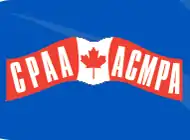Canadian Postmasters and Assistants Association
The Canadian Postmasters and Assistants Association or CPAA represents rural postal workers for the Canada Post Corporation. The trade union belongs to the Canadian Labour Congress as the federation's smallest National Union.
 | |
| Full name | CPAA-ACMPA |
|---|---|
| Native name | L'Association canadienne des maîtres de poste et adjoints |
| Founded | 1902 |
| Members | 12,000[1] |
| Affiliation | CLC |
| Key people | Brenda McAuley, National President; Dwayne Jones, National Vice-President; Daniel L. Maheux, National Vice-President |
| Office location | 281 Queen Mary, Ottawa, Ontario K1K 1X1 |
| Country | Canada |
| Website | www |
The organization publishes The Canadian Postmaster and hosts a Triennial Convention.[2]
History
The organization began in 1902 in Stonewall, Manitoba. From there, the trade union spread out through rural areas of Canada. In 2002, Canada issued a commemorative stamp for the organization's 100th anniversary.[3]
In recent years, the organization has struggled with closures of rural post offices designed to cut costs at Canada Post.[4] Even among rural post offices that remain open, many face cuts in hours and staff.[5]
Jurisdiction
The Association represents Canada Post employees who work in rural post offices. There are approximately 6,462 full and part-time permanent staff who are members of CPAA. In addition, there are approximately 5,209 term or temporary employees.
The CPAA represents the following classifications:[6]
- Semi-Staff Postmasters
- Group Postmasters
- Senior Assistants
- Full-Time Assistants
- Part-Time Assistants
In contrast, the Canadian Union of Postal Workers represents a larger majority of Canada Post's employees: 54,000 out of 72,000.[7] The rest belong the Association of Postal Officials of Canada (3,400 supervisors), the Union of Postal Communications Employees (2,600 technical workers) and the CPAA (12,000 rural workers).[8][9]
The CUPW put forward several merger proposals but, to date, the Canadian Postmasters have rebuffed them.[10]
See also
- National Rural Letter Carriers' Association, the US equivalent
References
- "Canadian Postmasters and Assistants Association, 1902-2002". Canada Post. 2002-07-05. Archived from the original on 2009-09-23. Retrieved 2010-09-26.
- "Publications". CPAA. 2010-03-01. Archived from the original on 2010-11-29. Retrieved 2010-09-26.
- "Canadian Postmasters and Assistants Association, 1902-2002". Canada Post. 2002-07-05. Archived from the original on 2009-09-23. Retrieved 2010-09-26.
- "Postmasters fear Canada Post may be planning more rural post office closures". The StarPhoenix as reprinted in Post & Parcel Magazine. 2005-02-21. Retrieved 2010-09-26.
- Miller, Jennifer (2010-08-25). "Reduced Whistler Post Office service eyed". Whistler Question. Retrieved 2010-09-26.
- "About us". CPAA. Archived from the original on 2010-11-30. Retrieved 2010-09-28.
- "Our Members". CUPW. Archived from the original on 2010-04-20. Retrieved 2010-09-28.
- "About APOC". Association of Postal Officials of Canada. Archived from the original on 2011-03-11. Retrieved 2010-09-28.
- "About Us". UPCE. Archived from the original on 2011-07-06. Retrieved 2010-09-28.
- Maheux, Daniel L. (2010-03-01). "Bargaining Unit Review". The Canadian Postmaster. Archived from the original on 2011-07-06. Retrieved 2010-09-28.